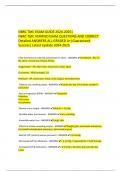NBRC TMC EXAM GUIDE 2024-2025|
NBRC TMC VERIFIED EXAM QUESTIONS AND CORRECT
Detailed ANSWERS ALL GRADED A+|Guaranteed
Success| Latest Update 2024-2025
4 life functions (in order) & assessment for them - ANSWER-✔Ventilation - RR, VT,
BS, chest. movement, PaCO2, EtCO2
Oxygenation - HR, Skin Color, Sensorium, PaO2, SpO2
Circulation - HR & strength, CO
Perfusion - BP, sensorium, temp, urine output, hemodynamics
Tobacco use, smoking status - ANSWER-✔# packs per day X # of years smoked =
pack years
Pysical inspection (IPPA) - ANSWER-✔Inspection
Palpation
Percussion
Auscaltation
Normal urine output - ANSWER-✔40mL/hr = 1L/day
Sensible water loss reasons - ANSWER-✔urine, vomiting
Insensible water loss - ANSWER-✔Lungs, skin
Affects of intake exceeding output - ANSWER-✔Weight gain, electrolyte imbalance,
increased hemodynamic pressures, decreased lung cst
Normal CVP (central venous pressure) - ANSWER-✔2-6 mmHg
Decreased CVP & indications - ANSWER-✔< 2 mmHg = hypovolemia = fluid therapy
Increased CVP & indications - ANSWER-✔> 6 mmHg = diuretics (furosemide aka
Lasix)
,Orientation x3 - ANSWER-✔Time, Place, Person
Orthopnea is: - ANSWER-✔difficulty breathing while lying down (CHF)
Dyspnea grades - ANSWER-✔Grade I: unusual exertion
Grade II: up hills or stairs
Grade III: walking at normal speed
Grade IV: slowly, walking short distance
Grade V: at rest, shaving, dressing, etc.
Proper interviewing techniques - ANSWER-✔Open-ended questions
Patient education - ANSWER-✔process of influencing the patient's behavior to
effect changes in knowledge, attitudes, & skills needed to maintain & improve health
Effective education - ANSWER-✔begins with an assessment of the patient's &
family's learning needs to determine what learning needs to occur & how the
learning can best occur.
Peripheral edema causes, locations - ANSWER-✔CHF, renal failure; arms & ankles
Acites - ANSWER-✔accumulation of fluid in the abdomen, generally caused by liver
failure
Clubbing definition; causes - ANSWER-✔When angle of the nail bed & skin increases;
chronic hypoxemia caused by COPD, CHF, CF, pulmonary diseases
Cap refill - ANSWER-✔Color should return within 3 seconds
JVD - ANSWER-✔jugular venous distention
CHF (left-sided heart failure)
On exhalation in patients with air trapping (decrease venous return)
Diaphoretic - ANSWER-✔profuse sweating
heart failure (diuretics, positive inotropics)
fever, infection (antibiotics)
anxiety, nervousness (sedatives)
TB (antitubercular drugs)
Erythema - ANSWER-✔redness of the skin (flushed, cap congestion, inflammation,
infection)
Cyanosis (definition) - ANSWER-✔5g decrease in hemoglobin
Pectus carinatum - ANSWER-✔forward protrusion of the sternum
Pectus excavatum - ANSWER-✔depression of part or all of the sternum
, Kyphosis (dowager's hump) - ANSWER-✔convex curvature of the spine (lean
forward)
Scoliosis - ANSWER-✔a lateral or side-to-side curvature of the spine
Kyphoscoliosis - ANSWER-✔combination of kyphosis & scolisis
restrictive lung pattern (reduced lung volumes)
barrel chest - ANSWER-✔increased AP diameter
result of chronic air trapping (COPD)
tripod breathing - ANSWER-✔sitting or standing, leaning forward and supporting
the upper body with hands on the knees or on another surface.
sign of respiratory distress
symetrical chest movement - ANSWER-✔when both sides of the chest move an
equal distance at the same time
Eupnea is: - ANSWER-✔normal respiratory rate, depth & rhythm
Normal respiratory rate - ANSWER-✔12-20 breaths per minute (adults)
*20 commonly used
Tachypnea - ANSWER-✔greater than 20 respiratory rate (rapid & shallow)
Bradypnea - ANSWER-✔aka oligopnea, less than 12 respiratory rate, variable depth
& irregular rhythm
Hyperpnea - ANSWER-✔increase in depth, rate, and regular rhythm of breathing
(deeper, sometimes faster than normal)
*causes: metabolic disorder, CNS disorders
Cheyne-Stokes - ANSWER-✔Gradually increase then decreasing rate and depth in a
cycle lasting from 30-180 seconds, with apnea lasting up to 60 seconds
Cheyne-Stokes causes - ANSWER-✔Increases ICP, brainstem injury, drug OD
Biot's breathing - ANSWER-✔groups of quick, shallow inspirations followed by
regular or irregular periods of apnea
Biots cause - ANSWER-✔CNS problems
Kussmaul's - ANSWER-✔Increased RR (>20 breaths/min), increased depth, irregular
rhythm, breathing sounds labored
Kussmaul causes - ANSWER-✔hypoxemia, DKA, metabolic acidosis, renal failure




